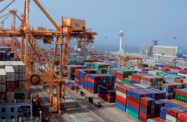Should the Gulf of Hormuz be closed to shipping, Saudi Arabia has proposed that the Kingdom’s Red Sea ports could be utilised for freight trans-shipment.
The recent rise in tension in the Gulf region is a result of Iran making a series of thinly veiled threats to close the strategic Strait of Hormuz in retaliation to a US-led tightening of sanctions against Tehran, including halting the country’s oil exports.
These threats to block the strait, which sees the passage of roughly 17m barrels of oil, some 20% of global needs and 35% of all tanker traffic, have helped keep oil prices above $100 a barrel, despite a general slowdown of the global economy. Some experts have tipped oil costs to rise to $150 a barrel or more by mid-2012, when the latest round of sanctions against Iran are set to be fully implemented.
However, while much of the focus of the media has been on the potential disruption to energy supplies, of equal concern to many states in the region is the threat to imports. The Gulf states are heavily reliant on imports to meet their staple requirements, such as food, consumer goods, raw materials for industry and other commodities, which mainly arrive by seaborne freight. Any disruption to shipping, either in or out of the Gulf, would be highly damaging to the economies of Saudi Arabia and its neighbours.
In the event that maritime trade in the Gulf is disrupted, Saudi Arabia has offered a partial solution, proposing that its string of Red Sea ports could take up at least some of the strain. In recent months, local and international media have run articles citing Saudi officials as saying preparations were being made to ready the Kingdom’s Red Sea ports for an additional flow of traffic should Gulf maritime trade be disrupted.
According to a report carried by the English-language Saudi Gazette in late January, cargo could be unloaded at Jeddah Islamic Port, Jizan Port, Yanbu Port, Dhiba or other facilities along the coast. Cargo would then be transported by land or air to their final destinations.
Though extensive, however, the road links from the Red Sea ports across Saudi Arabia to the Gulf may struggle to carry the volume of traffic needed to meet the region’s freight demands for an extended period of time, and it is unlikely that road-haulage firms would be able to find enough vehicles to handle the transport. A fully viable solution is still some way down the track, though it is moving closer to becoming a reality.
In late February, Saudi Arabia announced it was about to call for consultants to draft designs for the long-planned Landbridge rail project, which, when completed, will link the Red Sea with the Gulf, thus providing a high-speed, high-capacity, freight-moving service that would bypass the Hormuz bottleneck.
According to Mansour Al Maiman, the secretary general of the state-owned Public Investment Fund (PIF), invitations could be issued to consultants this month.
“After the appointment of the project manager, a tender will be launched targeting local contractors, who will form consortia with international companies to implement the project,” said Al Maiman, when speaking with Jeddah-based daily Okaz.
Ratified by the Council of Ministers last October, the Landbridge scheme foresees the construction of 950 km of line between Riyadh and Jeddah, a further 115 km of track linking Dammam and Jubail and the expansion of the existing line between Riyadh and Dammam. It is estimated that the line will have a capacity of around 8m shipping containers per year, with the capability of moving other cargo as well.
With a budget of around $7bn, the Landbridge will be one of the largest transport infrastructure projects undertaken in Saudi Arabia, and the one that could have the most wide-reaching effects on the local and regional economies.
The Landbridge, which is expected to be completed in the second half of the decade, will cut travel time between the two coasts and provide a secure link for trade, according to Abdul Aziz Al Hokail, the president of the Saudi Railways Organisation.
“Trains can take these goods from Jubail and Dammam ports and deliver them at the Jeddah Islamic Port, from where they can be sent on to Europe,” he said in a recent interview with the Arab News. “This will save a great deal of time and money. To give you an idea, a consignment from Dammam can reach Jeddah in 12 hours. The same journey takes more than a week by sea.”
Combined with other rail projects, such as a line running to the Jordanian border, and the GCC Railway Project – the 2000-km line that will connect Kuwait, Saudi Arabia, Qatar, the UAE and Oman – the Landbridge project will boost the Kingdom’s rail transport and industrial capacity and its ability to serve as a north-south and east-west logistics corridor.

